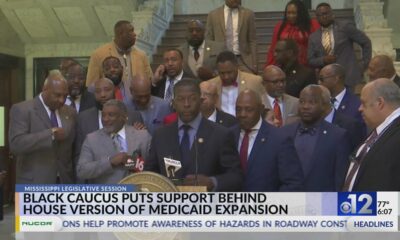Kaiser Health News
Raincoats, Undies, School Uniforms: Are Your Clothes Dripping in ‘Forever Chemicals’?
by Hannah Norman, Kaiser Health News
Tue, 04 Apr 2023 09:00:00 +0000
There could be more than just fashion risks involved when buying a pair of leggings or a raincoat.
Just how much risk is still not clear, but toxic chemicals have been found in hundreds of consumer products and clothing bought off the racks nationwide.
Thousands of perfluoroalkyl and polyfluoroalkyl substances, or PFAS, exist since the first ones were invented in the 1940s to prevent stains and sticking. PFAS chemicals are used in nonstick cookware, water-repellent clothing, and firefighting foam. Their manufacture and persistence in products have contaminated drinking water nationwide. Also known as “forever chemicals,” these substances do not break down in the environment and can accumulate in our bodies over time.
Drinking water is widely considered the greatest source of potential exposure and harm. And, in March, the Environmental Protection Agency proposed the first national standard for PFAS levels in drinking water. But the chemicals can also pollute soil, fish, livestock, and food products. Researchers say they are present in the blood of nearly all Americans.
Until now, federal regulations on PFAS in consumer products have largely focused on a handful of the older-generation forever chemicals, such as PFOA, or perfluorooctanoic acid. But new state-level laws are targeting all forever chemicals.
Consumers concerned about clothing are also turning to the courts. A torrent of recent class-action lawsuits claim brands falsely advertise their products as environmentally sustainable or healthy while containing toxic levels of PFAS chemicals. In January, Thinx, which makes reusable period underwear, agreed to pay up to $5 million to settle a suit. Another lawsuit, against REI, largely targeting its raincoat line, is proceeding in court.
From production to being worn, washed, and then disposed, “PFAS in clothing and textiles can lead to harmful exposures,” claimed Avinash Kar, a senior attorney at the National Resources Defense Council, an international nonprofit environmental advocacy organization.
Although the full health risks of wearing togs alleged to be toxic are still unknown, the potential implications are wide-reaching. A report from the National Academies of Sciences, Engineering, and Medicine linked PFAS exposure to cancer, thyroid dysfunction, small changes in birth weight, and high cholesterol, among other concerns.
So how concerned should consumers be about wearing clothing with forever chemicals in them?
PFAS have been found in a wide variety of garments such as rain jackets, hiking pants, shirts, and yoga pants and sports bras made by popular brands like Lululemon and Athleta.
Forever chemicals are used as surface treatments to block water and stains. In fact, a 2022 report by Toxic-Free Future, an environmental health research and advocacy organization, found that nearly three-quarters of products labeled as water- or stain-resistant tested positive for them.
The group points to research demonstrating that fabrics with that type of PFAS, called side-chain fluorinated polymers, emit volatile chemicals into the air and, when washed, into the water. “What you can expect is that a raincoat that has this surface treatment, over time, is releasing PFAS to the environment,” said Erika Schreder, Toxic-Free Future's science director.
PFAS can also be used as a membrane — a thin layer sandwiched in the fabric that blocks water from passing through. This technology is found in products made with Gore-Tex. Such breathable yet waterproof layers of fabric are used in jackets, pants, boots, and gloves in dozens of brands of outdoors wear. Sometimes, garments have both membranes and surface treatments.
A study published last year by the American Chemical Society found textile products sold in the U.S. and Canada contained high concentrations of PFAS in materials used in children's uniforms marketed as stain-resistant.
“This was concerning to us because these uniforms are on up to eight or 10 hours a day, every day, by children during their school year,” said Marta Venier, an assistant professor at Indiana University-Bloomington and co-author of the study. “Children are particularly susceptible to exposure to chemicals because their organs are still developing.”
But skin-touching fabric is only one way people are likely to be exposed to these chemicals. PFAS have found their way into most households through water, air, dust, and soap. PFAS can also shed from carpeting or furniture, as well as fabric treatments sprayed on furniture and clothing.
Studying skin or “dermal exposure” from wearing fabric is particularly tricky. Just because a product contains PFAS doesn't mean the chemical will travel from that jacket or pair of shorts across the skin into the bloodstream, said Stuart Harrad, a professor of environmental chemistry at the University of Birmingham.
So far, Harrad has found that PFAS can end up — either from fabric or dust particles — in the skin's oil and sweat. But more research needs to be done to examine whether those chemicals transfer into the blood. “From what we've seen, it's certainly something that we shouldn't be ignoring,” he said.
In general, however, it's harder for PFAS chemicals to enter the body through transdermal exposure than through the digestive system, said Dr. Ned Calonge, associate dean for public health practice of the Colorado School of Public Health who co-authored the national academies' report.
Levi Strauss has halted using the chemicals. Other brands, such as Patagonia, L.L. Bean, Lululemon, and Eddie Bauer, have pledged to phase them out in the next few years. In late February, REI released updated standards that require most cookware and textile products to be PFAS-free by fall 2024. The retailer said in a statement last year that it has been “working for years to phase out PFAS” and is “testing new alternatives.”
W.L. Gore & Associates, inventor of Gore-Tex and a giant manufacturer of weather-repellent fabric, said it plans to “transition the vast majority of its consumer portfolio by end of 2025.” Last year, the company debuted a membrane that uses non-fluorinated materials and can be found in jackets sold by Arc'teryx, Patagonia, and other brands.
Still, without oversight, corporate commitments are not a guarantee, and there's always concern of contamination, PFAS experts said. Gore, for example, said years ago that the company had eliminated PFOA from its materials. But in its testing last year, Toxic-Free Future found it in REI Gore-Tex rain jackets. Gore spokesperson Amy Calhoun rebutted those findings and said the company considers itself a leader in “responsible chemical management.”
People in the chemical field view this as an inflection point and are watching closely as companies phase out forever chemicals and pressing for transparency about what alternatives are chosen and how safe they might be.
The EPA has set out to regulate some older-generation chemicals generally found in imported products. Those have also been banned in the European Union and phased out by major U.S. manufacturers, often replaced by newer-generation PFAS, which leave the body more swiftly and are less likely to build up in organs. “When discussing the broad group of chemicals known as PFAS, it is important to note not all PFAS are the same,” said Calhoun. Some Gore products use PTFE, a polymer the company says is “of low concern.” According to a growing body of research, though, these newer PFAS often have similar levels of toxicity.
Stricter, state-level bans targeting apparel are rolling out. Maine now requires companies to report PFAS in their products to state officials. The chemicals will be fully banned there by the start of 2030, while Washington state will restrict PFAS in apparel as well as in other consumer products by 2025.
The most important legislation has come in two states with large consumer markets that manufacturers would be loath to avoid, effectively setting a standard for the nation. A New York law signed in late December bans the sale of garments with PFAS by the end of 2023. A California law passed last year restricts companies from manufacturing, distributing, or selling PFAS-containing clothing beginning in 2025, but those rules won't apply to extreme weather and personal protective apparel until 2028.
So where does that leave consumers? Calonge said that people who already have high levels of PFAS in their blood serum should have a heightened sense of awareness about the clothing they wear. Community-level blood testing is underway in areas with known PFAS exposure, but individuals can also seek it out by asking their doctors.
“That's when I would make a decision to not wear clothing that I know has PFAS in it,” he said.
Without sound evidence linking skin exposure from clothing to upticks in PFAS in blood serum levels, Calonge said, for now, decisions are largely left up to risk tolerance.
He personally draws the line at using dental floss brands shown to contain forever chemicals.
KHN (Kaiser Health News) is a national newsroom that produces in-depth journalism about health issues. Together with Policy Analysis and Polling, KHN is one of the three major operating programs at KFF (Kaiser Family Foundation). KFF is an endowed nonprofit organization providing information on health issues to the nation.
USE OUR CONTENT
This story can be republished for free (details).
By: Hannah Norman, Kaiser Health News
Title: Raincoats, Undies, School Uniforms: Are Your Clothes Dripping in ‘Forever Chemicals'?
Sourced From: khn.org/news/article/raincoats-undies-school-uniforms-are-your-clothes-dripping-in-forever-chemicals/
Published Date: Tue, 04 Apr 2023 09:00:00 +0000
Did you miss our previous article…
https://www.biloxinewsevents.com/fatigue-is-common-among-older-adults-and-it-has-many-possible-causes/
Kaiser Health News
To Stop Fentanyl Deaths in Philadelphia, Knocking on Doors and Handing Out Overdose Kits
Nicole Leonard, WHYY
Wed, 17 Apr 2024 09:00:00 +0000
On a narrow street lined with row houses and an auto body shop in the Kensington neighborhood of North Philadelphia, Marsella Elie climbs a home's front steps and knocks hard on the door.
A middle-aged man appears with a wary look on his face.
“Hello, sir, how are you doing today?” asked Elie, wearing a royal-blue jacket embroidered with the city government's Liberty Bell logo. “My name is Marsella. I'm working with the city. You heard about the overdoses that are going around in the neighborhood, right?”
The man gives a cautious nod.
Elie gestures to the pamphlets she's holding about drug overdoses and addiction treatment programs. She holds up a box of Narcan, a brand of naloxone, which can reverse an opioid overdose.
“What we're trying to do is get this in everybody's household. Have you ever heard of this before?” Elie asked before handing the man a tote bag filled with more pamphlets, fentanyl test strips, and the box of Narcan.
Elie and other part-time city workers and volunteers are part of a large-scale, citywide door-to-door campaign in Philadelphia that aims to equip homes with naloxone and other drug overdose prevention supplies.
City officials hope that this proactive approach will normalize naloxone as an everyday item in the medicine cabinet, and prevent people from dying of overdoses, especially Black residents.
In Philadelphia in 2022, a record 1,413 people died from drug overdoses, according to city data. Among Black residents, deaths were up 20% from the year before, with many happening in private homes.
“The best thing we can do to make these things more accessible is to just give them to people,” said Keli McLoyd, deputy director of the city's Opioid Response Unit, speaking about the tote bag with naloxone and other supplies. “We're not asking you if you're using drugs. The goal here is really to build sort of a collective responsibility. As Black and brown folks, as we saw during the covid epidemic, nobody's coming to save us. For us, this is a tool that we can use to save ourselves.”
The canvassing initiative aims to take prevention supplies directly to people who might not otherwise seek it out themselves, and to spread awareness about overdoses beyond Kensington, the epicenter of the city's addiction epidemic. Canvassers plan to knock on more than 100,000 doors in Philadelphia's “hot spots” — ZIP codes with escalating rates of opioid overdoses, many in minority communities.
Widening racial disparities in overdose deaths are among the long-term consequences of the war on drugs, McLoyd said. Policies from that national anti-drug campaign led to decades of aggressive police tactics, racial profiling, and lengthy prison sentences, disproportionately affecting people of color and their communities.
Research shows that Black Americans still account for a disproportionate number of drug arrests and child protective services.
“Because of that, it's very clear why Black or brown people might be hesitant to raise their hand and say, ‘I'm a person who uses drugs, I need those resources,'” McLoyd said.
Other communities have distributed naloxone and other supplies, albeit on a smaller scale than Philadelphia.
What Philadelphia is doing could become a model for other densely populated places, said Daliah Heller, vice president of drug use initiatives at Vital Strategies, a public health organization working with local governments in seven states to address the opioid epidemic.
“There's something intensely personal about a human engagement,” Heller said. “And somebody knocking at your door to talk about drug use and overdose risk and that there's something that can be done, I think is really powerful.”
Over the years, naloxone has become more accessible than ever before, Heller pointed out. It can now be ordered online and through the mail, it's available in specialized vending machines, and some drugstores now sell Narcan nasal spray over the counter.
But tens of thousands of Americans are still dying from opioid overdoses every year. That means prevention efforts and messaging about the crisis are still not reaching some people, Heller said. And to her, reaching people means meeting them where they are. “That means physically, that means in terms of what they know about something, what their perception is of something, and their beliefs,” she said. “We need to think like that when we think about naloxone distribution.”
The Philadelphia canvassing project is funded in part by the city's share of settlement payouts from national lawsuits against opioid manufacturers and distributors. The city is set to receive about $200 million over roughly 18 years from settlements with AmerisourceBergen, Cardinal Health, McKesson, and Johnson & Johnson.
The initiative is staffed by many of the same people who initially started canvassing as part of the 2020 census count.
Not everyone answers the door for the canvassers. Some aren't home when they come around. In those cases, workers hang a flyer on the door handle that offers information about overdose risks and contacts for further resources. The teams of canvassers, often with language interpreters, later make a second sweep through a neighborhood to reach people they missed the first time.
On a recent Thursday, Philadelphia canvassers were knocking on doors in the Franklinville and Hunting Park neighborhoods. In this ZIP code, about 85 people died of drug overdoses in 2022, according to city data. That's fewer than the 193 people who died of overdoses in Kensington in 2022, but much higher than the few deaths seen in the city's most affluent neighborhoods.
The canvassers approached a resident, Katherine Camacho, on the sidewalk, as she came out of her garage. Camacho told the teams she was aware of the overdose problem in her community and then eagerly accepted a box of Narcan.
“I will carry this with me, because, like I said, sometimes you're in the street driving somewhere and you could save a life,” Camacho told them. “And if you don't have these things, it's harder to do so, right?”
Camacho said she's seen how the opioid crisis has caused suffering in her neighborhood and across the city. As for Philadelphia's canvassing effort, she said she believes that “God is putting these people to help.”
As she headed into her house carrying the box of Narcan, Camacho said she wanted to do her part to help, too.
——————————
By: Nicole Leonard, WHYY
Title: To Stop Fentanyl Deaths in Philadelphia, Knocking on Doors and Handing Out Overdose Kits
Sourced From: kffhealthnews.org/news/article/fentanyl-deaths-philadelphia-narcan-overdose-kits-canvassing/
Published Date: Wed, 17 Apr 2024 09:00:00 +0000
Did you miss our previous article…
https://www.biloxinewsevents.com/paris-hilton-backs-california-bill-requiring-sunshine-on-troubled-teen-industry/
Kaiser Health News
Paris Hilton Backs California Bill Requiring Sunshine on ‘Troubled Teen Industry’
Molly Castle Work
Wed, 17 Apr 2024 09:00:00 +0000
Celebrity hotel heiress Paris Hilton is backing California lawmakers' push to increase the transparency of residential teen therapeutic centers by requiring these programs to report the use of restraints or seclusion rooms in disciplining minors.
“We shouldn't be placing youth in facilities without knowing what these children will be subjected to,” Hilton testified Monday to the Senate Human Services Committee in Sacramento. “The Accountability in Children's Treatment Act is a simple transparency measure that would make a lasting impact and show the world what truly happens behind closed doors.”
Hilton, 43, has become a high-profile advocate for getting tough on what she describes as the “troubled teen industry,” which promises to rehabilitate teenagers struggling with substance abuse, mental illness, and problematic behavior. Such programs lack federal oversight and have been exposed for riots, assaults, and even deaths of minors, prompting a pushback to protect the rights of young people.
After releasing a documentary in 2020 detailing abuse she faced while attending Provo Canyon School in Provo, Utah, as a teenager, Hilton traveled back to the state, helping pass a bill strengthening inspection and oversight of the industry. Advocates have successfully passed related laws in Illinois, Missouri, Montana, and Oregon.
Last year, Hilton went to Washington, D.C., to advocate for the federal Stop Institutional Child Abuse Act, which would establish best practices and transparency in youth residential care programs. But national efforts have failed for more than a decade and the latest proposal has been stalled for a year.
Related Articles
-
State Laws Aim to Regulate ‘Troubled Teen Industry,' but Loopholes Remain
Oct 17, 2014
-
Montana Is Sending Troubled Kids to Out-of-State Programs That Have Been Accused of Abuse
Oct 17, 2014
-
Montana Adds Protections for Kids in Private Residential Treatment Programs
Oct 17, 2014
Now, Hilton and others are eyeing the most populous state as an opportunity for change.
Senate Bill 1043 is a bipartisan bill by Republican state Sen. Shannon Grove and authored also by Democratic Sens. Aisha Wahab and Angelique Ashby. The bill aims to protect young people housed in short-term residential therapeutic programs licensed by the California Department of Social Services by requiring the agency to produce a public dashboard by 2026 on the use of restraint and seclusion rooms, and when it results in serious injuries or death. It would also require foster parents and guardians to be notified when restraints and seclusion rooms are used on minors.
“There are complaints of broken arms, slammed hands in doors,” said Grove, who noted that these facilities typically house vulnerable populations, including foster youth. “There's no data to show what happened and what caused that. And so, the goal is to go after the data.”
There was no formal opposition. The National Association of Therapeutic Schools and Programs, the nation's largest such member organization, told KFF Health News that it supports the California bill.
During Monday's hearing, Hilton shared that while she was housed at facilities in California, Utah, and Montana, she was subjected to abuse disguised as therapy. She said if she tried to tell her parents about the abuse, facility staff would rip the phone from her hand, restrain her, and force her into solitary confinement.
“When I close my eyes at night, I still have nightmares about solitary confinement 20 years later,” Hilton said. “The sounds of my peers screaming as they were physically restrained by numerous staff members and injected with sedatives will also never leave me.”
Zoe Schreiber, another survivor, said she was sent at age 13 to a Utah facility, where she was restrained face down in the mud by six adults for hours in the rain. Schreiber described enduring seclusion, hard labor, and humiliation for four years.
Democratic state Sen. Marie Alvarado-Gil, who chairs the Human Services Committee, said she had worked in such residential treatment facilities and noticed that staff often didn't have proper training.
“I don't think they're all bad, but I do think the ones that are bad, that impact the trauma of our children, that are unregulated, that are unstructured, that do not have evidence-based programming — I wonder how we get away with that here in California,” Alvarado-Gil said.
Wahab said it's important for California to act in the absence of a federal bill. California enacted related legislation in 2021 to prevent the state from sending foster children to out-of-state facilities.
“I'm hoping that we do some justice to the kids here,” Wahab said.
The Senate Human Services Committee passed SB 1043 on a 5-0 vote. The bill now goes to the Appropriations Committee.
This article was produced by KFF Health News, which publishes California Healthline, an editorially independent service of the California Health Care Foundation.
——————————
By: Molly Castle Work
Title: Paris Hilton Backs California Bill Requiring Sunshine on ‘Troubled Teen Industry'
Sourced From: kffhealthnews.org/news/article/paris-hilton-troubled-teen-industry-california-hearing/
Published Date: Wed, 17 Apr 2024 09:00:00 +0000
Did you miss our previous article…
https://www.biloxinewsevents.com/fda-announces-recall-of-heart-pumps-linked-to-deaths-and-injuries/
Kaiser Health News
FDA Announces Recall of Heart Pumps Linked to Deaths and Injuries
Daniel Chang and Holly K. Hacker
Tue, 16 Apr 2024 18:20:00 +0000
A pair of heart devices linked to hundreds of injuries and at least 14 deaths has received the FDA's most serious recall, the agency announced Monday.
Related Article
Patients Facing Death Are Opting for a Lifesaving Heart Device — But at What Risk?
The HeartMate 3 is considered the safest mechanical heart pump of its kind, but a federal database contains more than 4,500 reports in which the medical device may have caused or contributed to a patient's death.
The recall comes years after surgeons say they first noticed problems with the HeartMate II and HeartMate 3, manufactured by Thoratec Corp., a subsidiary of Abbott Laboratories. The devices are not currently being removed from the market. Abbott did not respond to KFF Health News' requests for comment.
The delayed action raises questions for some safety advocates about how and when issues with approved medical devices should be reported. The heart devices in question have been associated with thousands of reports of patients' injuries and deaths, as described in a KFF Health News investigation late last year.
“Why doesn't the public know?” said Sanket Dhruva, a cardiologist and an expert in medical device safety and regulation at the University of California-San Francisco. Though some surgeons may have been aware of issues, others, particularly those who do not implant the device frequently, may have been in the dark. “And their patients are suffering adverse events,” he said.
The recall involves a pair of mechanical pumps that help the heart pump blood when it can't do so on its own. The devices, small enough to fit in the palm of a hand, are implanted in patients with end-stage heart failure who are waiting for a transplant or as a permanent solution when a transplant is not an option. The recall affects more than 13,000 devices.
Amanda Hils, an FDA press officer, said the agency is working with Abbott to investigate the reported injuries and deaths and determine if further action is needed.
“To date, the number of deaths reported appears consistent with the adverse events observed in the initial clinical trial,” Hils said in an email.
According to the FDA's recall notice, the devices can cause buildup of “biological material” that reduces their ability to help the heart circulate blood and keep patients alive. The buildup accumulates gradually and can appear two years or more after a device is implanted in a patient's chest.
Doctors were advised to watch out for “low-flow alarms” on the devices and, if they do diagnose the obstruction, to either monitor the patient or perform surgery to implant a stent, release the blockage, or replace the pump.
A review of the FDA device database shows at least 130 reports related to HeartMate II or 3 that mention the complication reported by regulators. The earliest such report filed with the FDA dates to at least 2020, according to a KFF Health News review of the database.
Monday's alert is the second Class 1 recall of a HeartMate device this year.
In January, Abbott issued an urgent “correction letter” to hospitals about a separate issue in which the HeartMate 3 unintentionally starts and stops due to the pump's communication system, which cardiologists use to assess patients' status. The FDA alerted the public in March.
In February, Abbott issued another urgent letter to hospitals about the blockage problem, asking them to inform physicians, complete and return an acknowledgment form, and pay attention to low-flow alarms on the device's monitor that may indicate an obstruction. The company said in the letter that it is working on “a design solution” to prevent the blockages.
A study published in 2022 in the Journal of Thoracic and Cardiovascular Surgery reported the obstruction in about 3% of cases, though the incidence rate was higher the longer a patient had the device.
The only other Class 1 recall issued for the HeartMate 3 was in May 2018, when the company issued corrective action notices to hospitals and physicians warning that the graft line that carries blood from the pump to the aorta could twist and stop blood flow.
The FDA recall notice issued Monday includes additional guidance for physicians to diagnose the blockage using an algorithm to detect obstructions and, if needed, a CT angiogram to verify the cause.
At present, the HeartMate 3, which was first approved by the FDA in 2017, is the only medical option for many patients with end-stage heart failure and who do not qualify for a transplant. The HeartMate 3 has supplanted the HeartMate II, which received FDA approval in 2008.
If the new recall leads to the device being removed from the market, end-stage heart failure patients could have no options, said Francis Pagani, a cardiothoracic surgeon at the University of Michigan who also oversees a proprietary database of HeartMate II and HeartMate 3 implants.
If that happens, “we are in trouble,” Pagani said. “It would be devastating to the patients to not have this option. It's not a perfect option — no pump ever is — but this is as good as it's ever been.”
It's not known precisely how many patients have received a HeartMate II or HeartMate 3 implant. That information is proprietary. The FDA recall notices show worldwide distribution of more than 22,000 HeartMate 3 devices and more than 2,200 of the HeartMate II.
The blockage complication may have gone unreported to the public for so long partly because physicians are not required to report adverse events to federal regulators, said Madris Kinard, a former FDA medical device official and founder of Device Events, a company that makes FDA device data more user-friendly for hospitals, law firms, and investors.
Only device manufacturers, device importers, and hospitals are required by law to report device-related injuries, deaths, and significant malfunctions to the FDA.
“If this is something physicians were aware of, but they weren't mandated to report to the FDA,” Kinard said, “at what point does that communication between those two groups need to happen?”
Dhruva, the cardiologist, said he is looking for transparency from Abbott about what the company is doing to address the problem so he can have more thorough conversations with patients considering a HeartMate device.
“We're going to expect to have some data saying, ‘Hey we created this fix, and this fix works, and it doesn't cause a new problem.' That's what I want to know,” he said. “There's just a ton more that I feel in the dark about, to be honest, and I'm sure that patients and their families do as well.”
——————————
By: Daniel Chang and Holly K. Hacker
Title: FDA Announces Recall of Heart Pumps Linked to Deaths and Injuries
Sourced From: kffhealthnews.org/news/article/fda-recall-abbott-heart-pumps-heartmate-deaths-injuries/
Published Date: Tue, 16 Apr 2024 18:20:00 +0000
Did you miss our previous article…
https://www.biloxinewsevents.com/conservative-justices-stir-trouble-for-republican-politicians-on-abortion/
-
Mississippi News4 days ago
Mississippi will soon be bombarded with cicadas
-
SuperTalk FM3 days ago
4 tornadoes touched down in Mississippi during latest round of severe storms
-
SuperTalk FM4 days ago
2 Jones County correctional officers arrested in smuggling bust
-
Mississippi News5 days ago
Columbus schools may see needed upgrades with bond issue
-
Local News3 days ago
Almost 3,500 Mississippi Veterans have enrolled in VA health care in past 365 days, 28% increase over last year
-
SuperTalk FM15 hours ago
Chance of parole denied for man who killed 3 Choctaw Indian tribal members
-
SuperTalk FM6 days ago
Explosion at elementary school in Mississippi Delta hospitalizes two employees
-
Kaiser Health News17 hours ago
To Stop Fentanyl Deaths in Philadelphia, Knocking on Doors and Handing Out Overdose Kits





































